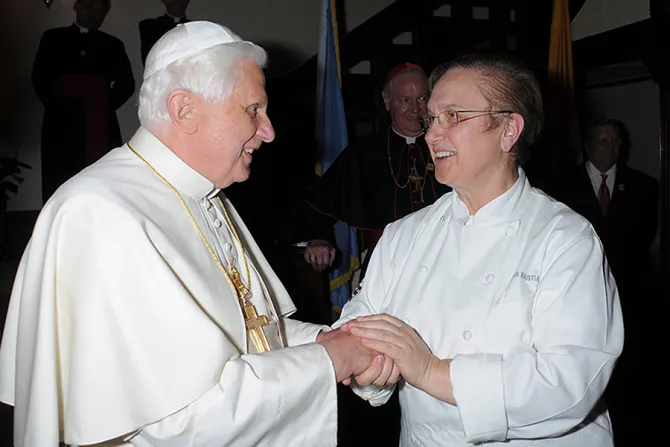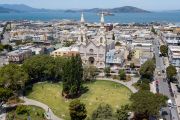"I was so happy that he ate, that he enjoyed it, that the memories were those of his childhood," she said. "I wanted to make him feel at home."
One special moment she recalls was when they brought in his birthday cake and sang "Happy Birthday" in English and Italian. They handed him the knife to cut the cake, but when he hesitated, Bastianich reached over. "I actually helped him cut it!" she laughed.
Another touching moment, Bastianich noted, took place after the dinner: a diplomat performed a violin sonata and Benedict invited the whole kitchen staff to come, sit down, and listen to the music with him.
Pope Francis
For Pope Francis, Bastianich's first instinct was to go with an Argentine theme and serve lots of meat, but the Vatican turned down her first menu proposal because Francis must eat lighter things for his health.
Instead she chose to focus on his northern Italian heritage, preparing heirloom tomatoes, house-made burrata, and steamed lobster; capon soup with Grana Padano raviolini, veal medallions, Boscaiola, porcini, corn, and fresh tomato; and concord grape sorbet with angel food cake for his first dinner in New York.
Bastianich and her staff were also in charge of preparing Francis' breakfasts, though all he wanted each morning was some fresh orange juice, tea, and toast.
They also prepared his bedside table at night with a glass of water and a banana, she said. "I put a few cookies, too. I wasn't supposed to, but I put a few cookies."
Friday's lunch consisted of cooked and raw vegetable salad with ricotta; risotto with porcini, summer truffles, and Grana Padano Riserva; and roasted pears and grapes with vanilla gelato.
At dinner they served pear and pecorino-filled ravioli, aged pecorino, whole roasted striped bass, late summer vegetables with extra virgin olive oil and lemon, and apple crostata with local honey ice cream.

(Story continues below)
Subscribe to our daily newsletter
One memory of Pope Francis' visit stands out for Bastianich in particular. After lunch on Friday, he went to rest in his room, she said. The staff were in the kitchen taking a coffee break and discussing their plans for the next meal when they suddenly heard the pope's security staff running and shouting "Papa, Papa!"
"And all of a sudden, we see [Pope Francis] enter the kitchen," she said. "And he peered in and said, "Posso avere un caffe, per favore?" – "Can I have a coffee, please?"
"He sipped on his espresso and he talked to each one of us. He spent a good 20 minutes with us in this simple kitchen, us dressed in our chef clothes. It was so intimate, so wonderful."
Before leaving, she recalled that "he reached into his pocket and pulled out a rosary for each one of us, and handing it to us said, 'pregate per me,' pray for me … It was extraordinary."
Her Catholic faith
Bastianich has been a Catholic from birth and said that personal prayer is very important to her. "I feel that ever more… I need to talk to God because I need his guidance," she said.




